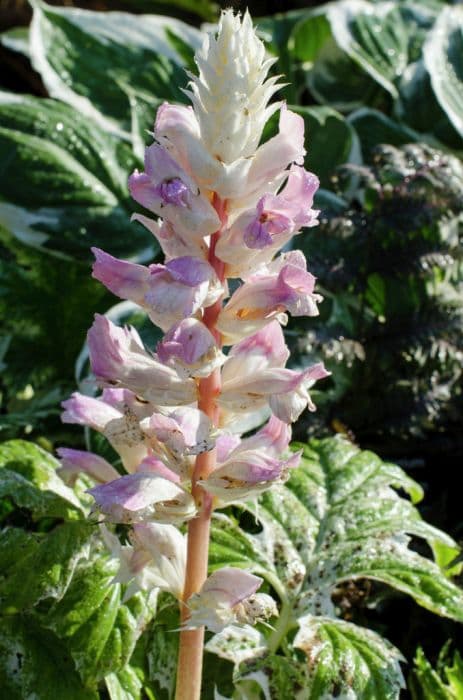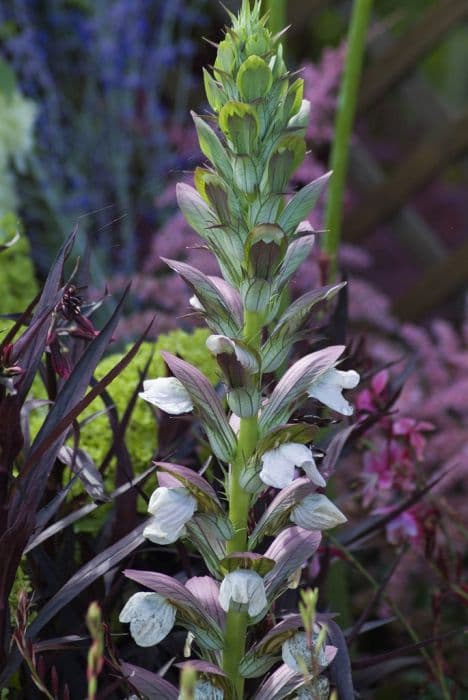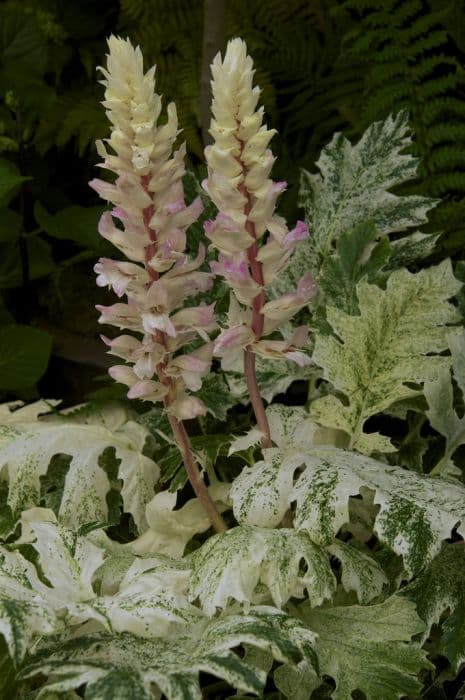Hungarian Bear's Breeches Acanthus hungaricus
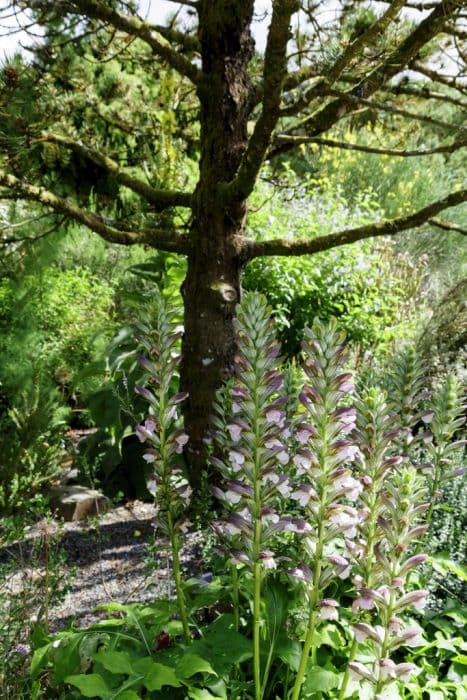
ABOUT
Commonly known as the Hungarian Bear's Breech, Acanthus hungaricus is an ornamental plant with distinctive foliage and floral characteristics. Its leaves are deeply lobed, glossy, and have a dark green color with a somewhat spiny appearance, resembling the paws of a bear, which is how it gets its name. The texture of the leaves is somewhat leathery, adding to the robust quality of the foliage. During the blooming period, the plant produces tall, erect flower spikes. The flowers are adorned with a striking display of white petals and purple bracts, which are modified leaves that sit just beneath the flowers. These bracts are often more noticeable than the actual flowers and give the spikes a bold, architectural look. The flower spikes can create a dramatic visual impact in the garden because they stand out against the dense foliage below. The blossoms are favored by gardeners for their unique shape and for the contrast they provide against the greenery. The overall form of the plant is that of a clump, with the leaves emanating mostly from the base. This arrangement creates a full, bushy appearance, contributing to its popularity as a decorative plant in gardens. It is often valued for its ability to provide a lush, Mediterranean feel to landscapes and its visual appeal throughout the growing season, from the sculptural leaves to the eye-catching summer blooms.
About this plant
 Names
NamesFamily
Acanthaceae
Synonyms
Hungarian Bear's Breech, Hungarian Acanthus
Common names
Acanthus hungaricus
 Toxicity
ToxicityTo humans
Acanthus hungaricus, commonly known as the Hungarian bear's breech, is not typically considered toxic to humans. There is little information available regarding its toxicity, suggesting that it does not generally pose significant risks upon ingestion. However, plants can sometimes cause allergic reactions or skin irritation due to physical contact with their spiky leaves. It is always advisable to exercise caution and avoid ingesting parts of ornamental plants due to potential unknown individual sensitivities or allergic reactions.
To pets
Hungarian bear's breech is not commonly listed among plants that are toxic to pets; there is limited information available on its toxicity. However, as with any non-food plant, ingestion can potentially cause mild stomach upset in pets. If a pet were to ingest a large amount of plant material, it might experience symptoms such as vomiting or diarrhea due to the unusual nature of the substance in its diet rather than specific toxic compounds in the plant. Always monitor your pets around plants and seek veterinary care if you observe any signs of distress after ingestion.
 Characteristics
CharacteristicsLife cycle
Perennials
Foliage type
Deciduous
Color of leaves
Green
Flower color
White
Height
3-4 feet (0.9-1.2 meters)
Spread
2-3 feet (0.6-0.9 meters)
Plant type
Herb
Hardiness zones
5
Native area
Balkans
Benefits
 General Benefits
General Benefits- Ornamental value: Acanthus hungaricus, commonly known as Hungarian Bear's Breeches, is valued for its striking foliage and elegant flower spikes, making it a popular choice for decorative purposes in gardens and landscapes.
- Drought tolerance: This plant is particularly hardy and able to withstand periods of drought, which makes it suitable for xeriscaping or areas with low water availability.
- Low maintenance: Hungarian Bear's Breeches requires minimal care once established, needing only occasional watering and pruning to maintain its appearance.
- Pollinator attraction: The flowers of Acanthus hungaricus attract bees and other pollinators, providing a valuable food source for wildlife and contributing to the health of the local ecosystem.
- Historical significance: Acanthus leaves have held historical importance in architecture and art, particularly in ancient Greek and Roman designs, making it an interesting and symbolic choice for classic garden themes.
- Architectural structure: With its bold leaves and tall flowering stalks, Hungarian Bear's Breeches adds structural interest to garden designs, creating a focal point or a backdrop for other plants.
 Medical Properties
Medical Properties- This plant is not used for medical purposes.
 Air-purifying Qualities
Air-purifying QualitiesThis plant is not specifically known for air purifying qualities.
 Other Uses
Other Uses- Acanthus hungaricus, commonly known as Bear's breech, is sometimes used in frescoes and paintings as a decorative element due to its distinct leaf pattern, giving artwork a touch of nature and classicism.
- The leaves of Bear's breech can serve as inspiration for architectural elements, such as Corinthian column capitals in classical architecture, reflecting its historical significance in design.
- The textured foliage of Bear's breech can be used for creating casts and impressions in art projects, where its detailed leaves make interesting and intricate patterns.
- Bear's breech may be used as a natural dye, where various parts of the plant can create subtle colors on fabrics, though specific color yield and techniques would require experimentation.
- This plant can act as an educational tool when studying the Acanthus genus, aiding in botanical illustration classes due to its visually distinct leaf shape and structure.
- Dried Bear's breech leaves are sometimes incorporated into dried flower arrangements to add volume and a unique texture contrast with their spiky appearance.
- In landscape design, Bear's breech is utilized as a structural plant to create formal garden patterns and shapes, emphasizing its robust and sculptural foliage.
- The seeds of Bear's breech can be used in crafts and jewelry, either as beads or simply as ornamental elements once treated and preserved properly.
- Bear's breech may be implemented in set design and theater productions, bringing an element of the wild and classical to stage environments.
- The plant is occasionally featured in photography and botanical studies for its aesthetic appeal and as an example of plant morphology, especially regarding leaf venation and structure.
Interesting Facts
 Feng Shui
Feng ShuiThe Acanthus is not used in Feng Shui practice.
 Zodiac Sign Compitability
Zodiac Sign CompitabilityThe Acanthus is not used in astrology practice.
 Plant Symbolism
Plant Symbolism- Artistic Inspiration: The Acanthus plant, particularly its leaves, is renowned for its use in classical Greek and Roman art and architecture; hence, it symbolizes creativity and the fine arts.
- Endurance and Perseverance: It can grow in difficult conditions and even through obstacles, which makes it a symbol of strength and the ability to withstand tough circumstances.
- Immortality and Eternal Life: In ancient times, the Acanthus leaf's longevity and evergreen nature were representative of enduring life and immortality.
- Healing: Because of its historical use in traditional medicines, the Acanthus can symbolize healing and restoration.
 Water
WaterThe Hungarian Bear's Breeches prefers even moisture, but it is quite drought tolerant once established. It should be watered deeply about once a week, although you may need to water more frequently during hot or dry spells. Provide about 1 to 1.5 gallons of water per plant for each watering session to ensure that moisture reaches deep into the root zone. During the winter months, when the plant is dormant, reduce watering significantly, only providing enough water to prevent the soil from completely drying out.
 Light
LightHungarian Bear's Breeches thrive in full sun to partial shade. It's best planted in a location that receives at least four to six hours of sunlight per day. However, the plant will appreciate some afternoon shade in very hot climates, as the intense sun can scorch the leaves.
 Temperature
TemperatureHungarian Bear's Breeches is hardy and can withstand temperatures as low as 10 degrees Fahrenheit, making it resilient in cold climates. The plant can survive up to about 90 degrees Fahrenheit before it starts showing signs of stress. The ideal temperature range for this perennial is between 60 and 75 degrees Fahrenheit, which promotes healthy growth.
 Pruning
PruningPrune Hungarian Bear's Breeches in late fall or early winter, after the plant has finished flowering and the foliage starts to decline. This helps to maintain its appearance and prevent seed spread, as it can become invasive. Cut back the spent flower stalks and any damaged or yellowing leaves. The best time for thorough pruning is when the plant is dormant to minimize stress.
 Cleaning
CleaningAs needed
 Soil
SoilHungarian Bear's Breech thrives in well-draining soil with a pH range of about 6.0 to 7.5. To create an ideal soil mix, combine equal parts of garden soil, peat or compost, and sharp sand to ensure good drainage while still retaining moisture. Amend with organic matter annually to maintain soil fertility.
 Repotting
RepottingHungarian Bear's Breech does not require frequent repotting as it's tolerant of being root-bound. Typically, repotting every 2 to 3 years or when the plant outgrows its current container is sufficient. Repot in spring before new growth begins.
 Humidity & Misting
Humidity & MistingHungarian Bear's Breech is adaptable and does not have high humidity requirements. It fares well in average room humidity conditions and does not need any special humidity adjustments when grown outdoors.
 Suitable locations
Suitable locationsIndoor
Use well-draining soil, place in bright, indirect light.
Outdoor
Plant in well-drained soil, full sun to partial shade.
Hardiness zone
5-9 USDA
 Life cycle
Life cycleAcanthus hungaricus, commonly known as Hungarian bears breech, begins its life cycle when seeds germinate in moist, well-drained soil, typically in early spring. Seedlings emerge and establish a root system, followed by the development of a rosette of dark green, lobed leaves. The plant undergoes vegetative growth, wherein it produces more leaves and gains energy through photosynthesis to support its development. In late spring to midsummer, Hungarian bears breech enters its reproductive phase, sending up tall flower spikes with white or pinkish-purple flowers, which are attractive to pollinators. After pollination, the flowers produce seed capsules that eventually dry and release seeds, thereby allowing the plant to propagate. During winter, Acanthus hungaricus dies back to the ground in colder climates, with its roots surviving to regenerate the following spring.
 Propogation
PropogationPropogation time
Spring-Early Summer
Propogation: The Hungarian Bear's Breech (Acanthus hungaricus) is commonly propagated by seed. The optimal time to begin this process is in spring after the threat of frost has passed. To propagate by seeds, one must first collect the seeds after the pods have dried on the plant. The seeds should be sown in well-draining soil at a depth of about 1/4 inch (approximately 6 millimeters), and kept moist until germination, which usually occurs within a few weeks. Seedlings can then be grown on in cooler conditions until they are large enough to transplant outdoors in the garden. It's important to space the young plants about 24 inches (roughly 61 centimeters) apart to allow them sufficient room to mature.
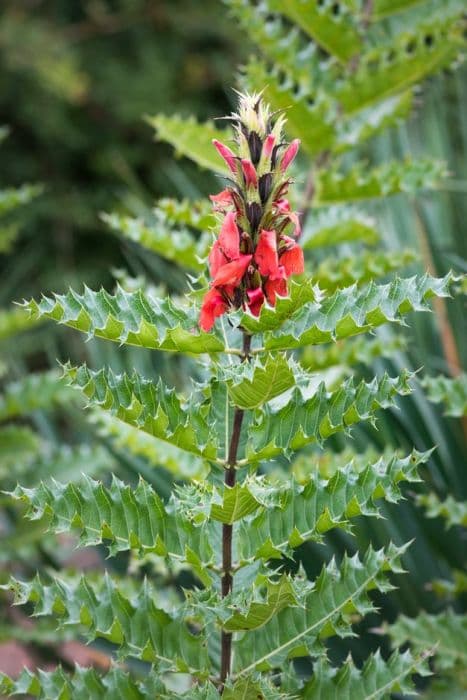
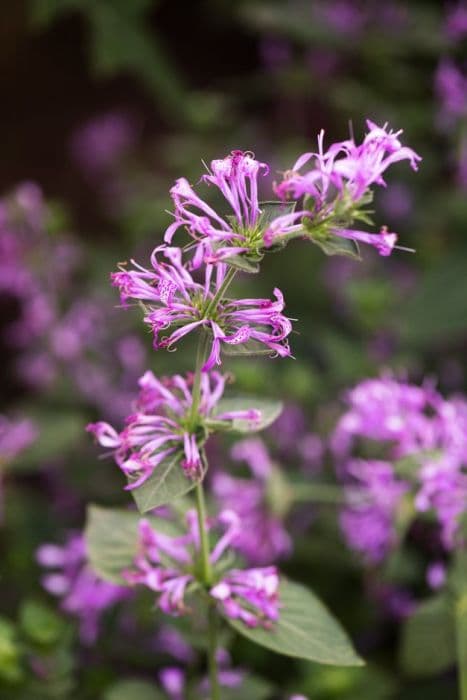
![Black-eyed Susan [Sunny Suzy Red-Orange]](/_next/image?url=https%3A%2F%2Fplants-admin.emdemapps.com%2Fimages%2Fplants%2F%2Fimages%2F607ea5891ee3f.jpg&w=640&q=75)

